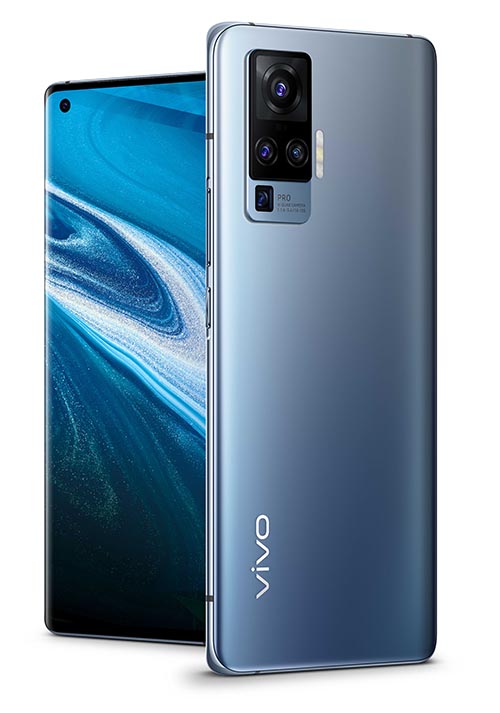You may not have heard of Vivo, but the new-ish name in phones is ready to crack the Australian mobile market. Owned by the company behind award-winning smartphone brand Oppo, Vivo has enjoyed rapid success in its home territory of Asia, with a focus on products for ‘youth culture’ and the goal to become a trend-setting brand worldwide.
Of course, you don’t need to be part of said ‘youth culture’ to pick up one of Vivo’s devices. One of the company’s higher-end entries into the Aussie smartphone market is the 5G-ready Vivo X50 Pro, which claims to offer a professional camera setup, fast performance and contemporary design for under $1,000. We tested out the dual-SIM, 5G-capable phone as an everyday device – read on for our review of the Vivo X50 Pro 5G.
Vivo X50 Pro 5G: features and specs
Here’s a quick list of the key features and specifications of Vivo’s X50 Pro 5G:
- From $999 RRP
- 6.5-inch AMOLED screen
- Quad Gimbal camera setup in rear (48MP, 13MP, 8MP, 8MP) and 32MP punch hole front camera
- Android 10 with Funtouch UI
- 4,315mAh battery with Vivo FlashCharge 2.0 fast charging
- Snapdragon 765G processor
- 5G connectivity
- Dual SIM
- Available in 256GB storage size with 8GB RAM
Vivo X50 Pro 5G: pros
- Excellent cameras with plenty of features
- Great performance and battery life
- Sleek design and feel
Vivo X50 Pro 5G: cons
- Single speaker only & no headphone jack
- No water or dust resistance
- Seasoned Android users may dislike FunTouch OS
Design

Even unboxing the Vivo X50 Pro feels like a premium experience, with the company delivering some of the most polished device packaging in recent memory. Out-of-the-box you’ll get the X50 Pro itself, plus power adaptor, headphones with a Type-C adaptor, and Type-C to USB cable, showing that Vivo hasn’t followed big name competitors such as Samsung and Apple in ditching the included charger and accessories with new devices.
The phone itself is beautiful to look at, with a blue-grey tone and a slim, sleek design. The 6.5-inch screen curves on both sides, which is visually appealing but may be off-putting for some potential buyers: while the curved edges weren’t a major inconvenience, they did occasionally interfere with swipes or taps when holding the device in one hand.
Vivo has nailed the ‘pro grade’ aesthetic for the X50 Pro’s rear camera system, housing it in a neat top-left rectangle that doesn’t take away from the phone’s colour and style. The device is also relatively lightweight when compared to other premium-level smartphones, and looks great when paired with a clear protective case.
There are a few flaws in terms of durability and ease of use. The X50 Pro doesn’t include a headphone jack, so if you’re not planning to go wireless, you’ll need to use the included Type-C adaptor to pair your device with earphones. You’ll also need to be extra careful if you’re lounging by the pool – the X50 Pro isn’t certified water or dust resistant, so heavy splashes could leave your phone out of commission.
The in-built speaker works well for calls and listening to podcasts, although the lack of stereo means music playback can be underwhelming. Overall, the audio is fairly loud, but I would recommend pairing the phone with a Bluetooth speaker (I used the portable LG Xboom Go in our tests) for best results when you don’t require earphones.
On the bright side, the X50’s screen is big, clear and great for video and games, and comes with a smooth 90Hz refresh rate that makes scrolling through social media a breeze. Vivo has produced a good phone for both viewing media and gaming, the downside being that you’ll need to be careful not to block the single left-side speaker if you’re using your device without headphones.
Performance and battery
The Vivo X50 Pro 5G is powered by a mid-range Snapdragon 765G processor, which means you’ll get reliable performance for just about everything you can do on your smartphone. If you’re looking for a device that can handle hard-core gaming or multi-tasking, you may want to go for something a little more high-end, but gaming-specific features such as Ultra-Game Mode and Game Assistant help position the X50 Pro as a phone that can take you from work to play.
The device runs a version of Android 10 with Vivo’s FunTouch user interface. If you’re a long-time Android user, you may prefer stock Android to the X50 Pro’s version, as the latter comes with a lot of pre-installed productivity apps you’ll probably never open. The ‘swipe down to answer calls’ gesture also takes some getting used to, and took a few attempts to figure out. However, I found FunTouch fairly easy to navigate overall, and the UI could be a good option for iPhone users looking to ease into Android.
The Vivo X50 Pro is 5G-capable, and I used it on Optus’ 5G network in Sydney with no issues – streaming, downloading, and uploading was fast in areas with 5G coverage. The ability to access 5G on the X50 Pro is a huge plus even if you’re not currently covered by the next-gen mobile technology, as it adds a slight amount of future-proofing not yet common in phones under $1,000.
In terms of battery, the X50 Pro offers great all-day life and at no point did the device dip below 20%. In fact, it performed just as well as much more expensive devices, and can easily make it through a full day of average to heavier use with plenty of charge left to spare.
The fast-charge compatibility makes top-ups quick and painless, but keep in mind that the device doesn’t support wireless charging. However, unless you’re a power user, you’re unlikely to be dependent on afternoon recharges to get through the day, so a fast after-work power-up should be sufficient if you’re taking the X50 Pro out on the town.
Cameras
Vivo has made photography a major focus in the X50 Pro by including a massive four-camera setup in the rear with a bevy of modes and features. If you’re planning to use your phone for video recording or action shots, the X50’s Gimbal camera support allows the main lens to rotate to track movement and increase image stabilisation – a feature that’s great for capturing sport, dancing, animals and kids.

The X50 Pro 5G’s array of in-built modes complement the rear camera system, giving users plenty of professional-grade options for snapping their portraits, landscapes, and even low-light and night-time photography. For general shots with no filters or special features applied, the X50 Pro holds up well, although colours can appear somewhat saturated in average lighting. The inclusion of up to 60X hybrid zoom also helps preserve details from afar, but delivers the best results with around 10X optical zoom.

Vivo has included a portrait camera modelled after a professional 50mm lens, which delivers crisp, detailed shots with well-balanced Bokeh effects in the background (but may leave feet and tails out of focus if you’re snapping pet pics, as shown below). This is one aspect of the X50 Pro that highlights its status as Vivo’s top smartphone, with colours and details remaining fairly true-to-life without the need for retouching.

The X50 Pro also includes some heavy-duty night and Astro modes, although you’ll want to use a tripod if you’re interested in taking your device stargazing. The great low-light performance is a huge plus for night owls moonlighting as amateur photographers, with Super Night mode delivering even in cloudy conditions.

By day, the Pro’s 8MP lens works well for macro shots, offering clear detail at a close range. While uploaded and scaled-down photos don’t do the camera justice, the Vivo X50 Pro 5G delivers results similar to those of serious high-end smartphones, but at a much lower price.
Is the Vivo X50 Pro 5G worth buying?
If finding a pro-grade phone camera for under $1,000 is a priority, the Vivo X50 Pro should definitely make your shortlist. However, you may also want to consider the Samsung Galaxy S20 FE (from $999 for the 5G model, or $849 for 4G-only), or the Google Pixel 5 or Pixel 4a 5G ($999 and $799 respectively), particularly if you do prefer to go with a more established brand.
Having said that, taking a chance on a lesser-known manufacturer can nab you a great device for a lower outright cost, and the Vivo X50 Pro makes a compelling argument for stepping out of your comfort zone. The X50 Pro was, overall, easy to use and offered a great performance with long-lasting battery life and no major hiccups, plus plenty of camera and video features to keep creatives occupied.
One caveat to be aware of is that the Vivo X50 Pro isn’t currently available from any Australian telcos, so you’re unable to buy from a mobile provider on a plan. You’ll need to pick up the device from a retailer such as JB HiFi, OfficeWorks, MobileCiti or The Good Guys, which means you may need to pay the full $999 upfront, rather than spreading the cost out over 12, 24 or 36 months.
However, this does give you a lot of options when it comes to picking a mobile plan, so it could save you some cash long-term when compared to being locked into a plan from Telstra or Optus. But be aware that if you’d like to take advantage of the Vivo X50 Pro’s 5G capabilities, you’ll need a provider that offers 5G coverage.
Consider the Vivo X50 Pro 5G if: you want a cheaper alternative to premium Android phones that still includes high-end camera specs and all-day battery.
SIM-only phone plans
If you’re planning to buy the Vivo X50 Pro 5G outright, you’ll need to pair it with a SIM-only mobile plan. We’ve compiled several postpaid and prepaid options below, but keep in mind that only Telstra, Optus, Vodafone and SpinTel currently offer 5G phone plans.
Here is a selection of postpaid plans from Canstar Blue’s database with a minimum of 20GB of data, listed in order of standard cost, lowest to highest, then by data allowance, largest to smallest. Try using our mobile phone plan comparison tool to see a wide range of plans from other providers. This table includes products with links to referral partners.
Here is a selection of prepaid plans from Canstar Blue’s database with a minimum of 10GB of data each month, listed in order of standard cost, lowest to highest, then by data allowance, largest to smallest. If you want to compare a larger range of offers from other providers, use our phone plan comparison tool. This table includes products with links to referral partners.


Share this article